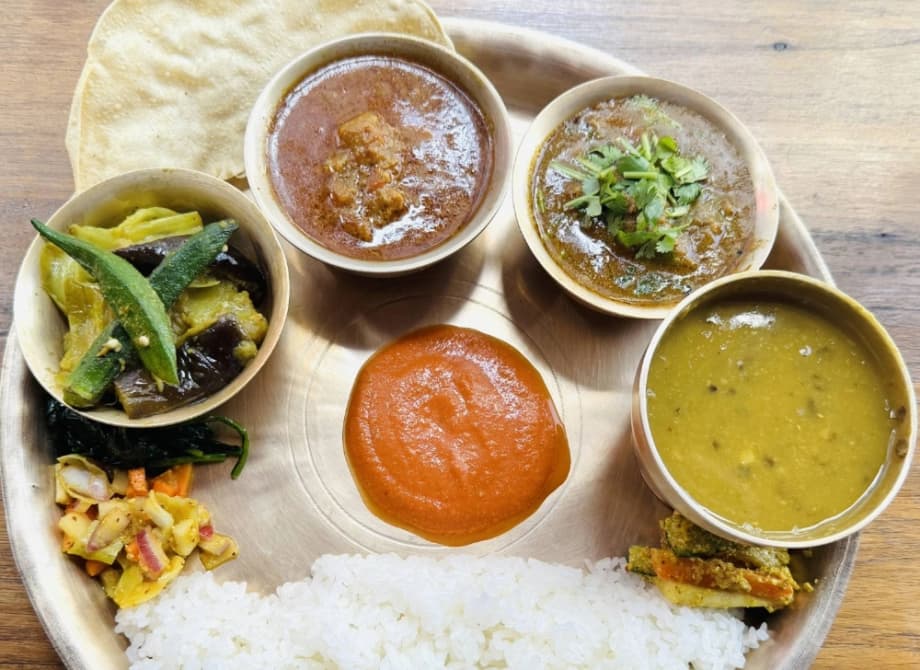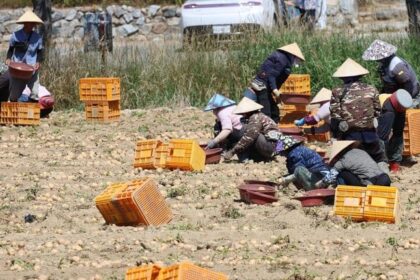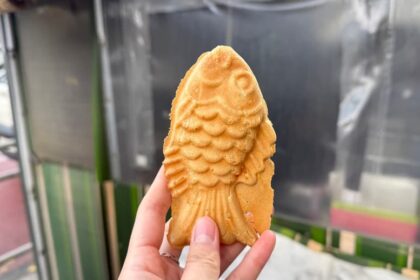A quiet revolution in Tokyo dining
Step into Nepalico in Shibuya and the mood changes. The walls carry a soft yellow glow, hand troweled so they look sun warmed. A double headed madal drum hangs overhead, the type played at weddings and festivals in Nepal. Framed photos show market stalls stacked with vegetables, and a distant Everest looks on. The setting is not stage craft for tourists. It is a personal tribute to rural life in Nepal, brought to Tokyo by owner Padam Devkota and his Japanese wife, who opened the restaurant in 2010.
Devkota grew up in Jarang in the Gorkha region of Gandaki Province. At home, his mother and grandmother made dal bhat tarkari, a plate of rice, lentils, vegetables and pickles served on a round thali. Their cooking avoided heavy garlic and chili, a Brahmin household preference that shaped his sense of flavor. That balance, clean and comforting, is what he set out to recreate in Tokyo.
He is part of a wave. Across the city, Nepali cooking is stepping out of the shadow of Indian cuisine. Chefs are focused on telling a Nepali story on the plate, and dal bhat has become the anchor. From casual counters to refined dining rooms, restaurants now treat this daily meal not as a side note, but as the main event. The result is a scene where home style comfort meets careful sourcing and, in some cases, Michelin level attention.
From home kitchens to neighborhood favorites
Nepalico’s appeal lies in familiarity and restraint. The Setagaya offshoot near Komazawa keeps lunch simple and affordable. Diners choose a curry set or dal bhat, with chicken, lamb, goat or vegetarian options and a gentle scale of spice. The chai is milky and fragrant, and service is unhurried. Many customers eat alone at the counter, as they might in a Tokyo ramen shop, and leave with the same sense of calm.
The curries lean light. Nepali gravies usually rely on spices and onions rather than buttery bases, so the sauces are neither thick nor watery. Meat simmers until tender. A small salad on the side cools the palate. It makes for a plate that feels nourishing, not heavy, which is one reason dal bhat has found a loyal midday following.
For many patrons, dal bhat is a memory as well as a meal. Trekkers who reached Everest base camp might recall being refueled by refills of rice and lentils at teahouses along the route. Tokyo’s version is served neatly on thali platters, with vegetables, pickles and sometimes a yogurt or a sweet to end. The spirit is the same. You mix, you taste, you eat until you are satisfied.
What makes dal bhat special
Dal bhat is less a single recipe than a way of eating. Rice and lentil soup are the constant, while the side dishes change with season, region and household custom. The goal is equilibrium. Many Nepali cooks describe it through taste, not technique. At one Tokyo dining room devoted to classic Nepali flavors, a sign at the entrance spells out that idea in plain language.
A bit sour, a bit spicy, a bit sweet, a bit astringent, a bit bitter, that is what makes dal bhat so tasty.
Restaurants across the city interpret that balance in different ways. Chyangra in Nezu builds a dal from a blend of urad, masur and mung beans enriched with butter and the Nepali herb jimbu, an allium that perfumes the soup without overpowering it. The rice blends Japanese grains with basmati and marshi, a red rice from Nepal, for aroma and gentle bite. Guests pick chicken or mutton curry, add a chataamari, the rice crepe often called Nepali pizza, and finish with Nepali tea or cooling mohi, a yogurt based drink.
Piple near Kasuga Station takes a spice forward approach. The kitchen grinds spices fresh and keeps vegetables at the center of the plate. The signature is dal bhat, presented as a complete, balanced meal. The atmosphere is casual and welcoming, with vegetarian options that make it an easy choice for groups that mix dietary preferences.
- Steamed rice, sometimes a blend of Japanese and Nepali varieties
- Dal, a lentil soup that can be silky or rustic, often seasoned with jimbu
- Tarkari, vegetables cooked with spices
- Achar, pickles that add acidity and heat
- Saag, quickly sautéed greens
- An optional curry, such as chicken or mutton
- Yogurt or mohi to cool the palate
Ambitious chefs push into fine dining
Dal bhat is not only a comfort food in Tokyo. It also appears at the center of tasting menus. Old Nepal, a reservation only restaurant in the capital, uses a set course to tell stories about the country. The entrance is understated, just a small lamp and a name on a dark facade. Inside, earthy tones, narrow corridors and the scent of incense hint at the old quarters of Patan or Bhaktapur. A dinner runs upward of 13,000 yen, and the kitchen is listed in the Michelin Guide.
Chef Ryo Honda first learned Nepali cooking in Kobe more than a decade ago, then traveled repeatedly across Nepal to study regional cuisines, from Tharu communities in the plains to Newari traditions in the Kathmandu Valley. He sources cumin, turmeric, jimbu, timur and pink Tibetan salt directly from Nepal and sells some of these spices upstairs at a small shop called Sunya. His aim is to present Nepali cuisine with care and to build respect for the craft, whether the dish is a simple dal or a complex course.
One tasting menu pays tribute to Mustang, the trans Himalayan region known for its stark beauty. Plates arrive in a sequence that mirrors the landscape, by color and texture. An apple themed course might glow red like Mustang’s orchards, a potato pickle leans gray like river pebbles, a green soup with rock trout evokes alpine herbs, a jet black buckwheat thukpa carries a hint of charcoal, and the dal bhat appears as a quiet centerpiece. A final ice cream or kulfi echoes the warmth of spices in a gentle finish.
Sourcing spices and telling stories
Old Nepal operates on one premise. Aroma tells the truth of Nepali food. The kitchen relies on spices brought from Nepal, then pairs them with Japanese ingredients at their peak. It is narrative cooking, but the method is honest. A good dal remains simple, a pickle still shocks the palate, and a curry tastes like home. Guests often leave with more than a full stomach. Many say they now want to see the places that inspired the menu.
Modern plates with Japanese ingredients
ADI in Nakameguro represents another path for Nepali food in Tokyo. Owner chef Kanchan Adhikari arrived in Japan in 2010 to study business, then turned to cooking, guided at first by tips from his mother back in Nepal. He tested recipes at a small lunch counter and a pop up, then opened his own place in 2020. He built relationships with farmers and fishmongers across Japan and receives ingredients daily. Before opening, he worked for two weeks at a seafood wholesaler in Yaizu to learn how to handle fish with care. His menus change with the morning deliveries, which means the side dishes on a dal bhat plate are rarely the same two days in a row.
The approach blends Nepali spice logic with Japanese seasonality. Lunch brings a vibrant plate anchored by rice and dal, with vegetables, chutneys and a small curry arranged around the edge. In the evening, an omakase tasting course shows a wider range, and a companion teahouse pours chai and bakes tea breads. The restaurant also produces condiments sold under its own label, and the wine list leans toward bottles that play well with spices rather than fight them.
Adhikari’s idea reflects a growing interest in direct connections between producers and restaurants. He visits farms and fisheries, learns what is in season and who harvested it, then builds plates that make the ingredients speak. Freshness and clarity matter. A new fish might appear one morning, and the team will call the wholesaler for advice before adapting it into a Nepali spiced dish. That kind of curiosity has helped ADI push beyond the curry house model without losing touch with comfort food.
Neighborhood spots keep it faithful
Tokyo’s Nepali map is dotted with small places that cook from the heart and keep prices friendly. Chyangra in Nezu specializes in set meals, centering on dal bhat with a choice of curry and a few classic extras. The chataamari on the side is popular with first timers. It looks like a thin pizza, but the rice batter base keeps it light and crisp.
Piple in Kasuga keeps the spotlight on spices and vegetables, with a calm interior that suits solo diners and families alike. The staff can accommodate vegetarian diets easily, and the goal is not flash, but balance and warmth. Dal bhat is the signature, as it is at many neighborhood counters that have built loyal followings among office workers and students.
Across central Tokyo, clusters of Nepali kitchens have grown near stations where commuters pass daily. In Shibuya, Shinbashi, Otsuka, Kanda and beyond, signage often highlights dal bhat alongside momos and thukpa. These menus are a link for Nepali communities and a discovery for Tokyoites who want a plate that is both familiar and new. Rice sits at the center, as it does in Japanese cooking. The spices carry the difference.
Why Nepali food is growing in Japan
The rise of Nepali restaurants reflects practical and cultural shifts. More Nepali cooks have made Japan their home, and many trained in kitchens where Indian and Nepali dishes were once blended on a single menu. Now they are building places that tell a more precise story. Diners in Tokyo have also grown curious about regional cuisines from South Asia. They want spice, but not heavy sauces every day. Dal bhat fits that need. It is affordable, adaptable, and naturally friendly to vegetarian and vegan diners.
Adaptation has played a role too. Many restaurants mix Japanese and Nepali rice, a nod to local texture and to supply chains. Vegetables track the seasons. Seafood appears more often than it would in a landlocked country, especially at modern spots that prize freshness. At the same time, core Nepali aromas remain intact. Jimbu adds a savory lift to dal. Timur, a pepper with citrus notes, pricks the tongue without overwhelming it. Some chefs even experiment with timur beer and other infusions, proof that the cuisine can change while staying rooted in familiar flavors.
How to order dal bhat in Tokyo
Ordering is straightforward. Most menus offer a set plate. Choose vegetarian or a meat curry, then pick a spice level. Ask what legumes are in the dal and whether the rice uses a blend. Some places will gladly provide an extra ladle of dal or a spoon of rice if you ask. Drinks often include milky chiya and a tangy yogurt based mohi.
There is no strict way to eat dal bhat, but a few tips help. Pour a little dal over the rice and mix. Add a spoon of curry and some vegetables. Taste the pickle sparingly at first, then adjust. Alternate bites so the plate stays interesting. Finish with yogurt or tea to cool the spices. Many restaurants serve chatamari or a small dessert if you want to extend the meal.
- Ask if the dal uses jimbu for a traditional aroma
- Look for rice blends that include Japanese grains and marshi red rice
- Pick a spice level that lets you taste the lentils and pickles
- Try chatamari or a small appetizer to sample more textures
- Pair with chiya or mohi, both complement spices
- Vegetarian sets are common and filling
- Lunchtime sets often offer the best value
Key Points
- Dal bhat, a daily Nepali meal of rice, lentils and sides, is now a centerpiece at many Tokyo restaurants
- Nepalico in Shibuya and Setagaya showcases home style cooking with gentle spicing and calm settings
- Chyangra in Nezu highlights a multi bean dal, jimbu herb and a rice blend of Japanese, basmati and marshi
- Piple near Kasuga emphasizes fresh ground spices and vegetable forward plates with dal bhat as the signature
- Old Nepal presents a reservation only set course, sources spices directly from Nepal and is listed in the Michelin Guide
- Chef Ryo Honda builds storytelling menus, including a Mustang themed course that still centers on dal bhat
- ADI in Nakameguro blends Nepali spice logic with Japanese ingredients, changing side dishes daily based on fresh deliveries
- Tokyo’s Nepali dining growth reflects curiosity for regional cuisines, health focused meals and the city’s rice culture
- Spices like jimbu and timur preserve Nepali aromas while chefs adapt to local produce and seafood
- Ordering dal bhat is simple, and many restaurants offer vegetarian options, mild spice levels and value lunch sets












